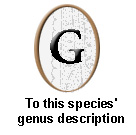Doryllium minor
Jairajpuri, 1963
Measurements: Holotype female: L = 0.52 mm; a = 26; b
= 4.2; c = 24; V = 36%; width = 19.8 um; esophagus
= 125 um; tail = 19.2 um; prerectum = 48 um.
Females (8): L = 0.47 + 0.02 (0.44-0.50); a = 27.2
+ 1.4 (24-29); b = 4.3 + 0.3 (3.9-4.9); c =
26.9 + 0.8 (26-28); V = 39.7% + 1.4 (37-41); width = 17.4
um + 1 (16-19.2); esophagus = 109.7 um + 6
(102-120); tail = 17.5 um + 0.7 (16-18.4); prerectum = 41.3
um + 6.3 (32-49.6).
Differential Diagnosis: Doryllium minor is close
to D. cornelli (van der Linde, 1938) Jairajpuri, 1963, but can be
distinguished by the absence of a distinct cuticularized lining of the
stoma and by the shorter spear relative to the length of the spear extension.
Holotype Female: Body cylindrical, slightly arcuate.
Cuticle and subcuticle with fine transverse striations. Lateral cords
5um wide; body pores not observed. Head offset, margin rounded,
inner liplets forming disc-like structure around oral opening. Stoma
obscure; amphids cup-shpaded, 4um wide. Spear distinct, 4.8um
long; spear extension indistinct, 8um long, flanged. Nerve
ring about midway along esophagus. Esophagus slender, with constricted
basal bulb 36um long and 13um wide. Cardia rounded,
5um long. Vulva transverse, vagina 9um long. Anterior
gonad reduced to short rudimentary branch, 6.4um long; posterior
gonad normal, 21% body length, reflexed 90%. Prerectum distinct;
rectum 11um, as long as anal body width. Tail elongate, hemispheroid;
cuticle at teminus very thick; caudal papillae present.
The Indiana specimens were very similar in morphology and measurement
to the holotype.
Male not seen.
Distribution and Habitat: Holotype collected from soil
around apple trees in north India. Indiana specimens collected from
forest areas in Tippecanoe State Park, Pokagon State Park, Versailles State
Park, Fallen Timber Creek State Park, Clifty Falls State Park, Salamonie
River State Forest, Portland Arch near Attica, and Camp Limberlost near
La Grange.
(Description- Goseco, Ferris & Ferris, 1975)
 |
 |



